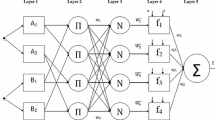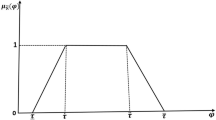Abstract
This paper introduces a novel adaptive inverse multilayer T-S fuzzy controller (AIMFC) optimally identified with an optimization soft computing algorithm available for a class of robust control applied in uncertain nonlinear SISO systems. The parameters of multilayer T-S fuzzy model are optimally identified by the differential evolution (DE) algorithm to create offline the inverse nonlinear plant with uncertain coefficients. Then, the adaptive fuzzy-based sliding mode surface is applied to ensure that the closed-loop system is asymptotically stable in which the stability is satisfied using Lyapunov stability concept. The control quality of the proposed AIMFC algorithm is compared with the three recent advanced control algorithms applied in the Spring-Mass-Damper (SMD) benchmark system. Simulation and experiment results with different control parameters show that the proposed algorithm is better than the inverse fuzzy controller and the conventional adaptive fuzzy controller comparatively applied in both SMD system and the coupled-liquid tank system with the performance index using the least mean squares (LMS) error, which is investigated to demonstrate the efficiency and the robustness of the proposed AIMFC control approach.






















Similar content being viewed by others
References
Zadeh LA (1965) Fuzzy sets. Inf Control 8(8):338–3365
Precup, Radu-Emil, and Hans Hellendoorn. "A survey on industrial applications of fuzzy control." Computers in Industry62.3 (2011): 213–226
Qiu J, Gao H, Ding SX (2016) Recent advances on fuzzy-model-based nonlinear networked control systems: a survey. IEEE Trans Ind Electron 63(2):1207–1217
Chiu C-S (2010) TS fuzzy maximum power point tracking control of solar power generation systems. IEEE Trans Energy Conversion 25(4):1123–1132
Rezaee B, Fazel Zarandi MH (2010) Data-driven fuzzy modeling for Takagi–Sugeno–Kang fuzzy system. Inf Sci 180(2):241–255
Cheung NJ, Ding X-M, Shen H-B (2014) OptiFel: a convergent heterogeneous particle swarm optimization algorithm for Takagi–Sugeno fuzzy modeling. IEEE Trans Fuzzy Syst 22(4):919–933
Zou W, Li C, Zhang N (2017) A TS fuzzy model identification approach based on a modified inter Type-2 FRCM algorithm. IEEE Trans Fuzzy Syst
Salhi I, Belattar A, Doubabi S (2017) Takagi–Sugeno fuzzy modeling for three-phase micro hydropower plant prototype. Int J Hydrog Energy 42(28):17782–17792
Tseng C-S, Chen B-S, Uang H-J (2001) Fuzzy tracking control design for nonlinear dynamic systems via TS fuzzy model. IEEE Trans Fuzzy Syst 9(3):381–392
Xiaodong L, Qingling Z (2003) New approaches to H∞ controller designs based on fuzzy observers for TS fuzzy systems via LMI. Automatica 39(9):1571–1582
Nasiri, Alireza, et al. "Reducing conservatism in H¥ Robust State Feedback Control design of TS Fuzzy Systems: A Non-monotonic Approach." IEEE Transactions on Fuzzy Systems(2017)
Wei, Yanling, et al. "A New Design of $ H $-Infinity Piecewise Filtering for Discrete-Time Nonlinear Time-Varying Delay Systems via T–S Fuzzy Affine Models." IEEE Transactions on Systems, Man, and Cybernetics: Systems 47.8 (2017): 2034-2047
Mendel JM, Bob John RI (2002) Type-2 fuzzy sets made simple. IEEE Trans Fuzzy Syst 10(2):117–127
Mendel JM (2014) General type-2 fuzzy logic systems made simple: a tutorial. IEEE Trans Fuzzy Syst 22(5):1162–1182
Li H, Wu C, Shi P, Gao Y (2015) Control of nonlinear networked systems with packet dropouts: interval type-2 fuzzy model-based approach. IEEE Trans Cybernetics 45(11):2378–2389
Kumbasar T, Eksin I, Guzelkaya M, Yesil E (2012) Type-2 fuzzy model based controller design for neutralization processes. ISA Trans 51(2):277–287
Kumbasar T, Eksin I, Guzelkaya M, Yesil E (2017) An inverse controller design method for interval type-2 fuzzy models. Soft Comput 21(10):2665–2686
Berrazouane S, Mohammedi K (2014) Parameter optimization via cuckoo optimization algorithm of fuzzy controller for energy management of a hybrid power system. Energy Convers Manag 78:652–660
Soufi, Youcef, Mohcene Bechouat, and Sami Kahla. "Fuzzy-PSO controller design for maximum power point tracking in photovoltaic system." International Journal of Hydrogen Energy42.13 (2017): 8680–8688
Sundarabalan CK, Selvi K (2017) Real coded GA optimized fuzzy logic controlled PEMFC based dynamic voltage restorer for reparation of voltage disturbances in distribution system. Int J Hydrog Energy 42(1):603–613
Lutz A, Bonderev V, Fiesnski C (2017) Fuzzy neural network optimization and network traffic forecasting based on improved evolution. Neural Networks & Mach Learn 1(1):2–2
Chen C-H, Liu C-B (2017) Reinforcement learning-based differential evolution with cooperative coevolution for a compensatory Neuro-fuzzy controller. IEEE Trans Neural Networks Learning Syst
Tu K-Y, Lee T-T, Wang W-J (2000) Design of a multilayer fuzzy logic controller for multi-input multi-output systems. Fuzzy Sets Syst 111(2):199–214
C. Van Kien, N. N. Son, and H. P. H. Anh, “Identification of 2-DOF Pneumatic Artificial Muscle System with Multilayer Fuzzy Logic and Differential Evolution Algorithm,” in The 12th IEEE Conference on Industrial Electronics and Applications (ICIEA 2017), 2017, pp. 1261–1266
Labiod S, Boucherit MS, Guerra TM (2005) Adaptive fuzzy control of a class of MIMO nonlinear systems. Fuzzy Sets Syst 151(1):59–77
Lai G, Liu Z, Zhang Y, Chen CP, Xie S, Liu Y (2016) Fuzzy adaptive inverse compensation method to tracking control of uncertain nonlinear systems with generalized actuator dead zone. IEEE Trans Fuzzy Syst 25(1):191–204
Mi, Yang, et al. "Intelligent Power Sharing of DC Isolated Microgrid Based on Fuzzy Sliding Mode Droop Control." IEEE Transactions on Smart Grid (2018)
Wang, Yueying, et al. "Dissipativity-based fuzzy integral sliding mode control of continuous-time TS fuzzy systems." IEEE Transactions on Fuzzy Systems (2017)
Xue Y, Zheng B-C, Xinghuo Y (2017) Robust sliding mode control for TS fuzzy systems via quantized state feedback. IEEE Trans Fuzzy Syst
Li, Hongyi, et al. "Adaptive sliding mode control for Takagi-Sugeno fuzzy systems and its applications." IEEE Transactions on Fuzzy Systems (2017)
Li, Jinghao, et al. "Observer-Based Fuzzy Integral Sliding Mode Control For Nonlinear Descriptor Systems." IEEE Transactions on Fuzzy Systems (2018)
Wen, Shiping, et al. "Fuzzy control for uncertain vehicle active suspension systems via dynamic sliding-mode approach." IEEE Transactions on Systems, Man, and Cybernetics: Systems 47.1 (2017): 24–32
Li, Jinghao, et al. "Robust Stabilization of TS Fuzzy Stochastic Descriptor Systems via Integral Sliding Modes." IEEE transactions on cybernetics (2017)
Li, Yongming, and Shaocheng Tong. "Adaptive fuzzy output-feedback stabilization control for a class of switched nonstrict-feedback nonlinear systems." IEEE transactions on cybernetics47.4 (2017): 1007–1016
Liu, Yan-Jun, et al. "Adaptive Fuzzy Output Feedback Control for a Class of Nonlinear Systems with Full State Constraints." IEEE Transactions on Fuzzy Systems (2018)
Zhou, Qi, et al. "Adaptive fuzzy control for non-strict-feedback systems with input saturation and output constraint." IEEE Transactions on Systems, Man, and Cybernetics: Systems 47.1 (2017): 1–12
Li Y, Sui S, Tong S (2017) Adaptive fuzzy control design for stochastic nonlinear switched systems with arbitrary switchings and unmodeled dynamics. IEEE Trans Cybernetics 47(2):403–414
Tong, Shaocheng, et al. "Observer-based adaptive fuzzy backstepping control for a class of stochastic nonlinear strict-feedback systems." IEEE Transactions on Systems, Man, and Cybernetics, Part B (Cybernetics) 41.6 (2011): 1693-1704
Li H, Wang L, du H, Boulkroune A (2017) Adaptive fuzzy back-stepping tracking control for strict-feedback systems with input delay. IEEE Trans Fuzzy Syst 25(3):642–652
Liu, Heng, et al. "Adaptive fuzzy back-stepping control of fractional-order nonlinear systems." IEEE Transactions on Systems, Man, and Cybernetics: Systems 47.8 (2017): 2209–2217
Sadek U, Sarjaš A, Chowdhury A, Svečko R (2017) Improved adaptive fuzzy back-stepping control of a magnetic levitation system based on symbiotic organism search. Appl Soft Comput 56:19–33
Raju GVS, Zhou J, Kisner RA (1991) Hierarchical fuzzy control. Int J Control 54(5):1201–1216
Wang D, Mu C (2017) Adaptive-critic-based robust trajectory tracking of uncertain dynamics and its application to a spring mass-damper system. IEEE Trans Ind Electron 99(99):1–10
Shen Q, Shi P, Wang S, Shi Y (2019) Fuzzy adaptive control of a class of nonlinear systems with unmodeled dynamics. Int J Adapt Control Signal Process 33(4):712–730
Zhang F, Hua J, Li Y (2018) Indirect adaptive fuzzy control of SISO nonlinear systems with input–output nonlinear relationship. IEEE Trans Fuzzy Syst 26(5):2699–2708
Zhang F, Li Y, Hua J (2018) Direct adaptive fuzzy control of SISO nonlinear systems with input–output nonlinear relationship. Int J Fuzzy Syst 20(4):1069–1078
Storn R, Price K (1997) Differential evolution–a simple and efficient heuristic for global optimization over continuous spaces. J Glob Optim 11(4):341–359
Acknowledgements
This paper is funded by Vietnam National University of Ho Chi Minh City (VNU-HCM) under grant number B2020-20-04. We acknowledge the support of time and facilities from Ho Chi Minh City University of Technology (HCMUT), VNU-HCM for this study.
Funding
This study was funded by Vietnam National University of Ho Chi Minh City (VNU-HCM) under grant number B2020-20-04.
Author information
Authors and Affiliations
Corresponding author
Ethics declarations
Conflict of interest
Corresponding author Ho Pham Huy Anh is supported by Vietnam National University of Ho Chi Minh City (VNU-HCM) under grant number B2020-20-04.
There is no conflict of interest from authors related to this manuscript.
Additional information
Publisher’s note
Springer Nature remains neutral with regard to jurisdictional claims in published maps and institutional affiliations.
Rights and permissions
About this article
Cite this article
Van Kien, C., Anh, H.P.H. & Son, N.N. Adaptive inverse multilayer fuzzy control for uncertain nonlinear system optimizing with differential evolution algorithm. Appl Intell 51, 527–548 (2021). https://doi.org/10.1007/s10489-020-01819-9
Published:
Issue Date:
DOI: https://doi.org/10.1007/s10489-020-01819-9




